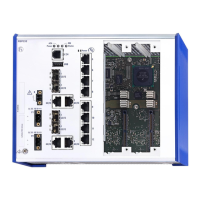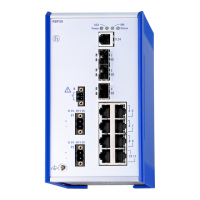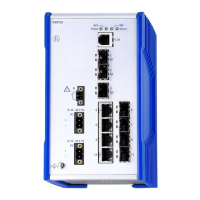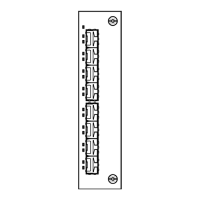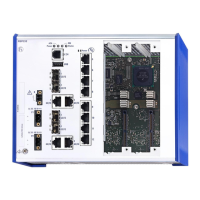
Do you have a question about the Hirschmann RSPE30 and is the answer not in the manual?
| Device Type | Managed Industrial Ethernet Switch |
|---|---|
| Type of Housing | Metal |
| Protection Class | IP30 |
| Operating Temperature | -40°C to +70°C |
| Redundant Power Supply | Yes |
| Mounting | DIN Rail |
| Power over Ethernet (PoE) | No |
| Redundancy Functions | MRP, RSTP, PRP, HSR |
| Management | Web-based, CLI, SNMP |
| Protocols | SNMP |
Covers different supply voltage options and their characteristic values like K9, KK, CC, PP.
Details the supply voltage connection using a 3-pin terminal block for characteristic value K9.
Covers redundant power supply options using 3-pin terminal blocks for characteristic value KK.
Describes redundant power supply connections using 2-pin terminal blocks for characteristic value CC.
Explains redundant power supply connections using 2-pin terminal blocks for characteristic value PP, supporting PoE(+).
Describes the various Ethernet ports available, including twisted pair and combo ports.
Explains the Power over Ethernet (PoE/PoE+) capabilities of specific RSPE device variants and their standards.
Covers the physical installation of the device onto a DIN rail and its grounding.
Procedures for mounting the device onto a 35 mm DIN rail, including clearance requirements.
Explains how to ground the device using the dedicated grounding screw on the front.
Detailed instructions for connecting power supply and signal wires to terminal blocks.
Detailed connection of DC and AC supply voltage using a 3-pin terminal block for characteristic value K9.
Instructions for connecting supply voltage (DC/AC) for characteristic value KK, noting redundant supply priority.
Details connecting DC supply voltage using a 2-pin terminal block for characteristic value CC.
Covers connecting DC supply voltage for PoE/PoE+ using a 2-pin terminal block for characteristic value PP.
Covers initial IP address setup and default device configurations.
Describes options for configuring IP addresses, including V.24, HiView, BOOTP, DHCP, and ACA.
General safety precautions for operating the device with electricity and handling it properly.
Guidelines on using the product only for described applications and according to technical specifications.
Requirements for installing the device in specific environments, including fire enclosures and temperature limits.
Precautions regarding opening the casing, inserting objects, and ensuring proper ventilation.
Specifies requirements for connecting signal contacts and supply voltages, including UL standards.
